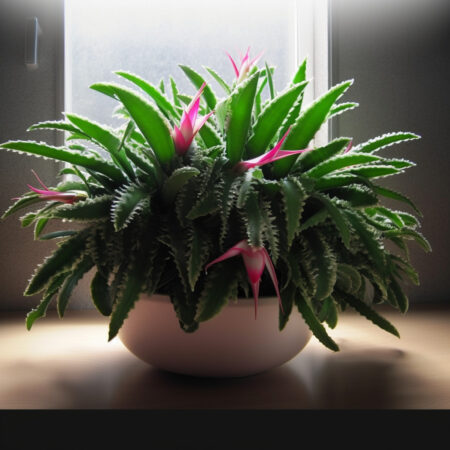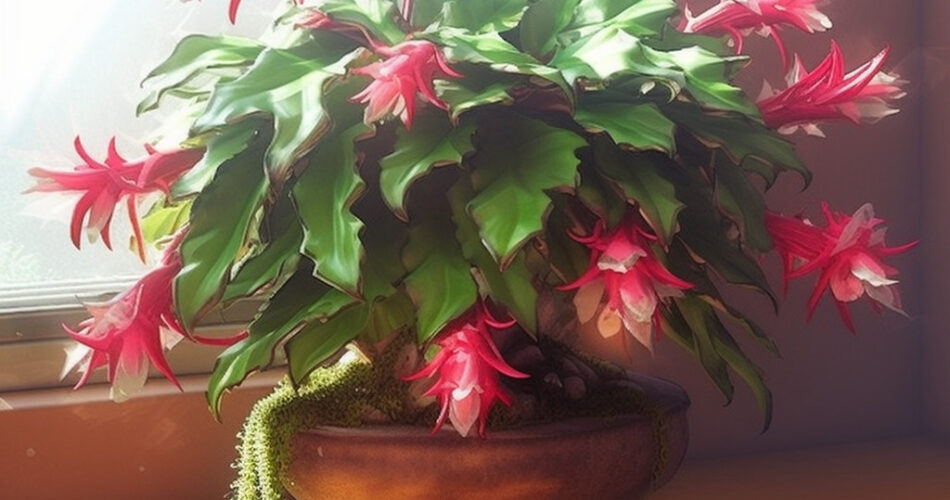Key Takeaways:
- Schlumbergera, also known as holiday cactuses or Christmas cactuses, are native to the coastal mountains of Brazil and are renowned for their vibrant flowers that bloom during the holiday season.
- It is associated with resilience, endurance, and the celebration of life in harsh conditions.
- The two main species of Schlumbergera are Schlumbergera truncata and Schlumbergera x buckleyi, with numerous hybrids and cultivars available.
- What sets this cacti apart from other cactuses is their leaf-like stems, serrated edges, and preference for indirect light, high humidity, and cooler temperatures.
- To successfully grow it, provide optimal growing conditions, choose the right container and potting mix, and understand watering, fertilizing, and propagation techniques.
- Protect it from pests and diseases, prune and shape for optimal growth, and create the right conditions for blooming.
- Display it creatively, learn uncommon facts and myths, and try advanced care techniques like experimenting with hybrid varieties and controlled pollination.
The Captivating Schlumbergera: Unveiling the Mysteries of the Christmas Cactuses
Welcome to a comprehensive guide that will take you on a journey through the enchanting world of Schlumbergera, the Christmas cactus. In this article, we will delve deep into the origin, symbolism, varieties, and unique characteristics of these exquisite plants. We will also provide you with step-by-step instructions on how to successfully grow and care for your own Schlumbergera, along with essential tips and tricks to ensure their thriving and blooming. But that’s not all – we will also explore creative display ideas, uncommon facts, and myths surrounding this captivating plant. Plus, we’ll offer expert advice for the more advanced care takers. So, let’s get started and unlock the secrets of Schlumbergera!
1. Discovering the Enchanting Schlumbergera: A Brief Introduction
Schlumbergera, commonly known as holiday cactuses or Christmas cactuses, are stunning plants that have captured the hearts of many plant enthusiasts around the world. Native to the coastal mountains of Brazil, these epiphytic cactuses belong to the family Cactaceae. They are renowned for their vibrant and elongated flowers that bloom during the holiday season, adding a pop of color to the festive atmosphere. But there’s more to Schlumbergera than just their blooms.
1.1 The Origin and Symbolism of Schlumbergera
The name Schlumbergera honors Frederic Schlumberger, a French cactus collector who played a pioneering role in introducing and studying these plants in Europe during the 19th century. Over time, Schlumbergera became associated with the holiday season, symbolizing resilience, endurance, and the celebration of life in the face of harsh conditions.
1.2 Varieties: Exploring the Diverse Species
There are primarily two main species of Schlumbergera – Schlumbergera truncata and Schlumbergera x buckleyi. Truncata, commonly known as Thanksgiving cactus, typically blooms in late fall, while x buckleyi, also known as Christmas cactus, blooms closer to the actual holiday season. However, there are numerous hybrids and cultivars available today, each with its own peculiarities and charm.
1.3 The Unique Characteristics: What Sets Them Apart
What distinguishes it from other cactuses is their leaf-like stems, serrated edges, and pendulous growth habit. Unlike typical desert cactuses, these plants prefer indirect light, high humidity, and cooler temperatures. They also have interesting reproductive aspects – their flowers require a period of cool temperatures to initiate bud formation, making them a natural fit for the winter season.

Cultivating: A Step-by-Step Guide to Successful Growth
Now that we have a basic understanding of Schlumbergera, let’s dive into the intricate process of cultivating these delicate plants. Providing optimal growing conditions, selecting the right container and potting mix, and understanding watering, fertilizing, and propagation techniques are all key to your it’s success.
2.1 Optimal Growing Conditions: Providing the Perfect Environment
This cactus thrives in bright, indirect light, ideally near an east or west-facing window. They prefer temperatures between 60-70°F (15-21°C) during the day and slightly cooler temperatures at night. Additionally, they require high humidity levels, which can be achieved by placing the plant on a tray filled with pebbles and water. Avoid exposing them to drafts or temperature extremes, as this can cause bud drop.
2.2 Container Selection and Potting Mix: Ensuring the Right Home
Choosing the right container and potting mix is crucial for your cactuses overall health. Select a container with drainage holes to prevent waterlogging. As for the potting mix, a well-draining soil blend with a pH level between 5.5-6.2 is recommended. You can create your own mix by combining peat moss, perlite, and coarse sand.
2.3 Watering, Fertilizing, and Propagation: Nurturing Your Schlumbergera
Watering your cactus correctly is vital to its well-being. During the growing season, allow the top inch of soil to dry out before watering thoroughly. In winter, when the plant is dormant, reduce watering to prevent root rot. Fertilize it monthly during the growing season with a balanced, water-soluble fertilizer. Propagation can be done through stem cuttings, which should be taken in spring or early summer.
Thriving: Essential Care Tips and Tricks
Now that you know how to grow your Schlumbergera, it’s time to learn how to keep them healthy and thriving. Protecting them from pests and diseases, pruning and shaping for optimal growth and form, and maximizing their blooming potential are all essential care aspects.
3.1 Protecting Schlumbergera from Pests and Diseases
It can be susceptible to pests such as mealybugs and scale insects. Regularly inspect the plant for any signs of infestation and take immediate action, using natural or chemical methods as necessary. Additionally, watch out for common diseases like root rot and fungal issues, which can be avoided by ensuring proper watering techniques and good airflow around the plant.
3.2 Pruning and Shaping Schlumbergera: Enhancing Growth and Form
Pruning your cacti helps maintain its shape, encourages bushier growth, and improves blooming. After the flowering period, remove any dead or decaying stems. To promote branching, pinch off a section of a healthy stem. Pruning can be done throughout the year, but avoid heavy pruning during the bud formation phase.
3.3 Encouraging Blooming: Maximizing the Splendor of Holiday Cactuses
For it to blossom prolifically, they require a period of cool temperatures and decreased daylight hours. About six weeks before the desired bloom time, expose your plant to temperatures of around 50-55°F (10-13°C) for 12-14 hours each day. Additionally, ensure they have a dark period of 12-14 hours every night. Following these conditions, your cactus will reward you with a burst of magnificent blooms.
Beyond the Basics: Unlocking the Potential of Schlumbergera
If you’re ready to dive even deeper into the world of Schlumbergera, this section will take you there. We’ll explore creative display ideas, uncover uncommon facts and myths, and provide expert tips for the more adventurous plant enthusiasts.
4.1 Creative Display Ideas: Showcasing the Beauty
Schlumbergera’s stunning blooms deserve to be showcased in unique and creative ways. Consider placing them in decorative pots, hanging baskets, or terrariums. You can also create a stunning centerpiece by arranging different colored Schlumbergera together. Let your creativity flow and experiment with various display options to enhance the beauty of these magnificent holiday cactuses.
4.2 Uncommon Facts and Myths: Surprising Insights
Did you know that Schlumbergera flowers come in a wide range of colors, including red, pink, orange, white, and even bi-colored varieties? Or that they were once believed to bring good luck and prosperity? Separate fact from fiction as we unravel some of the uncommon facts and myths surrounding Schlumbergera.
4.3 Taking on the Challenge: Expert Tips for Advanced Care
If you’re an experienced plant enthusiast looking to take your cactus to the next level, we have some expert tips for you. These include experimenting with different hybrid varieties, testing out specialized fertilizers, and even attempting controlled pollination to create your own unique Schlumbergera hybrids. Challenge yourself and unlock the full potential of these captivating holiday cactuses!
With this comprehensive guide, you are now equipped with the knowledge and insights to successfully grow, care for, and marvel at the incredible beauty of Schlumbergera. From their origin and symbolism to cultivation and beyond, each aspect of this guide has been crafted with the aim of expanding your understanding and appreciation for these captivating holiday cactuses. So, go forth and create an enchanting Schlumbergera haven in your home, and let the magic of these plants brighten up your holidays!
FAQ
Question: Are Schlumbergera and Christmas cactuses the same?
No, It is the scientific name for a group of cactuses commonly known as holiday cactuses, which include Christmas cactuses. There are different species and hybrids within the Schlumbergera group.
Question: How do Schlumbergera cactuses differ from typical cactuses?
These cactuses have leaf-like stems, serrated edges, and a preference for indirect light, high humidity, and cooler temperatures. They are also known for their vibrant flowers that bloom during the holiday season.
Question: What are the optimal growing conditions for Schlumbergera?
It thrives in bright, indirect light, temperatures between 60-70°F (15-21°C) during the day, slightly cooler temperatures at night, and high humidity levels. They should be protected from drafts and temperature extremes.
Question: How often should I water my Schlumbergera?
During the growing season, allow the top inch of soil to dry out before watering thoroughly. In winter, reduce watering to prevent root rot.
Question: How can I protect my Schlumbergera from pests and diseases?
Regularly inspect the plant for pests such as mealybugs and scale insects. Take immediate action using natural or chemical methods as necessary. Avoid overwatering to prevent root rot and provide good airflow around the plant to prevent fungal issues.
Question: When and how should I prune my Schlumbergera?
After the flowering period, remove any dead or decaying stems. To promote branching, pinch off a section of a healthy stem. Avoid heavy pruning during the bud formation phase.
Question: How can I encourage blooming in my Schlumbergera?
Expose your Schlumbergera to temperatures of around 50-55°F (10-13°C) for 12-14 hours each day, about six weeks before the desired bloom time. Ensure they have a dark period of 12-14 hours every night.
Question: Can I create my own unique Schlumbergera hybrids?
Yes, advanced plant enthusiasts can experiment with different hybrid varieties and attempt controlled pollination to create their own unique Schlumbergera hybrids.




Comments